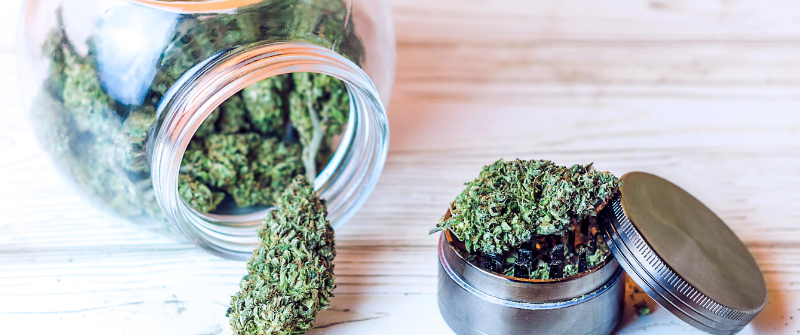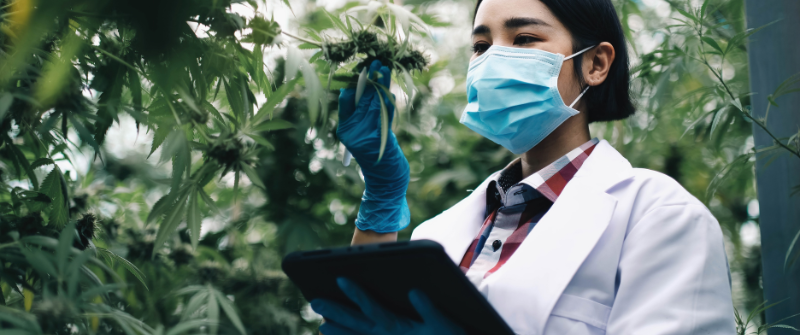
For many, cannabis is a safe alternative medicinal therapeutic that effectively treats their mental and physical health symptoms to improve their well-being and productivity.
Despite being the most commonly used federally illegal substance across the country, and the most abused substance after alcohol and opioids, annually, almost 50 million people rely on marijuana for self-medication, according to the Substance Abuse and Mental Health Administration. People ages 18-25 have the highest rate of use.
Evidence is emerging every day on how beneficial cannabis is, especially with prolonged use. For many, it’s a safer and better-tolerated medicine than conventional drugs and treatment. While the prevailing wisdom is that marijuana is harmless, regular use is associated with various adverse side effects.
Cannabis is a powerful plant that can be used in many ways. The dried leaves and stems can be broken down into smaller pieces, known as flower. The substance can also be converted into different forms for use topically as a salve, lotion, ointment, or concentrates that can be smoked, vaped, or consumed sublingually. Regardless of how users consume it, marijuana use comes with risks that can negatively impact overall health and quality of life.
Much of the bad hype surrounding the marijuana plant is about its psychoactive effects or mind-altering properties. Despite more awareness and scientific evidence identifying and highlighting the differences between the various properties, primarily cannabinoids, many assume that all types of cannabis are dangerous. That’s simply not true.
The cannabinoids in marijuana are compounds that interact with the endocannabinoid in the body. Also called the ECS, the system is a highly complex cellular communication network made of endocannabinoids, cannabinoid receptors, and enzymes that influence various functions in the brain and body.
The most popular cannabinoid discovered to date in the marijuana plant is tetrahydrocannabinol or THC. THC is the cannabinoid responsible for the mind-altering and dissociative effects many experience with use. Cannabidiol, or CBD, is another dominant compound in the marijuana plant.

People have been using marijuana for centuries to improve their health and moods. While there’s no shortage of positive claims about the effects of cannabis. Today’s medical weed is much more potent than the strains cultivated in the past. Higher potency equates to more severe side effects. Because modern cannabis is more potent, the risks are significantly higher for users, no matter the consumption form.
As beneficial as cannabis is for millions of medical and recreational users around the world, there are some real risks to consider. Anyone who uses cannabis is susceptible to the side effects; however, some individuals are more vulnerable than others.
As THC enters the bloodstream, it travels throughout the body and to the brain, where it binds with specific receptors in the brain and alters the normal function of various processes. Consumption methods highly influence the effects of cannabis. Smoking and vaping marijuana have a much faster onset than eating or using the substance topically. Those who smoke cannabis typically feel the effects within minutes, whereas users who consume often notice the effects within 30 minutes to an hour later.
Marijuana is an addictive substance with a high potential for misuse. Youngsters who partake in the substance before adulthood often develop an overdependence on it. Cannabis causes abnormal changes in the brain of children and adolescents¹ because their brains are still developing.
It’s estimated that 30 percent of users are likely to develop cannabis misuse disorder². To give you a better idea of the propensity for abuse, one out of every six adolescents and one in 10 adults will develop a marijuana addiction. Currently, there’s no definitive evidence of the effects of high-potency cannabis on addiction. That may change in the future.
Numerous studies highlight the correlation between marijuana use and diminished cognitive function and mental health. Marijuana use at an early age also changes how the brain builds connections between different pathways and regions necessary for proper function and development. People who use the substance at a young age are more likely to have a significant and possibly permanent decline in IQ. Whereas older users don’t.
In addition to lower cognitive function and emotion regulation, cannabis causes the following effects on the brain.
The harmful neurological and cognitive effects of frequent cannabis use include depression, anxiety, psychosis, suicidal ideation, substance abuse, and other mood disorders. Currently, the verdict is out on whether prolonged use causes permanent brain damage or impairment.
A study performed by Duke University researchers showed that cannabis use during adolescence that continues into adulthood can cause a permanent 8-point drop in cognitive performance³. Although researchers show these effects may be permanent even after cessation, they were exclusive to individuals who started using during their teens.

Some researchers allege marijuana use decreases cognitive motor function even after use. People who operate heavy machinery or operate motor vehicles while under the influence of cannabis are a danger to themselves and others. Not only does the substance slow down their reactions, coordination, and decision-making functions, but it also triggers abnormal changes in the cortico-striatal networks in the brain⁴ that regulate memory, motor skills, coordination, and reaction times.
Surprisingly, mounting scientific evidence shows that regular use is linked with fewer cognitive changes and impairments than sporadic or occasional use. Many researchers believe this is because regular use increases tolerance, and the brain is better able to compensate for the side effects of marijuana on the brain.
Marijuana’s side effects negatively influence daily behaviors, affecting overall performance and well-being. Users are at risk of experiencing relationship problems with their relatives, friends, coworkers, and partners. They are also likely to have lower IQ, education, career potential, and decreased satisfaction with life. Many studies show a link between cannabis use and low potential, motivation, and increased irresponsible behaviors.
Marijuana has both positive and negative effects on the body. Among the adverse changes are the following:
The negative effects of cannabis on respiratory health and function are largely associated with smoking it. The dangers of smoking on the lungs are well-documented, and many of them apply to users who smoke marijuana. Smoke inhalation causes irritation and inflammation of the lungs, causing users to develop breathing issues like coughing, congestion, and respiratory infection.
These concerns are exclusive to those who smoke cannabis. However, some question whether vaping, a reportedly healthy alternative to traditional smoking, carries the same risks. Individuals who use alternative consumption methods are least likely to experience them.
There are claims that cannabis use while pregnant and nursing/breastfeeding can impair the fetus’s brain and physical development, which continues into childhood and beyond. Among the adverse effects linked to marijuana and pregnancy are low birth weights, premature births, brain development deficiencies, and low cognitive function.
Many claim mothers who use cannabis while breastfeeding inadvertently put their child’s physical and mental development at risk. THC is a fat-soluble substance that accumulates in breast milk, increasing the risk of abnormal interactions in the brain chemistry, function, and nervous system functions of nursing infants and young children. There’s also the possibility of negative endocannabinoid function. Endocannabinoids are natural cannabinoids synthesized by the body that are essential for many physiological, physical, and mental functions.
Currently, there is limited evidence on the dangers of using marijuana while pregnant, except for those who smoke it. There is also mounting evidence on the positive effects of cannabis use during pregnancy.
For example, hyperemesis gravidarum is a serious medical disorder and difficult complication of pregnancy that makes it difficult to keep fluids and foods down. The condition causes extreme feelings of nausea and vomiting that can quickly lead to nutritional issues and dehydration without medical intervention. Women who develop hyperemesis while expecting are unable to rely on common remedies like ginger, frequent snacking, increased hydration, or prescription antinausea meds like Zofran.
Although cannabis use during pregnancy is illegal, many women find that the substance provides more relief from the condition. Marijuana’s anti-nausea and antiemetic properties help improve their appetites and make many other less pleasant and intolerable pregnancy symptoms easier to manage. More research is necessary to determine the true effects of cannabis on expectant mothers and their developing babies.

Many users notice an uptick in cardiac activity shortly after using marijuana which can last for several hours. While this has the potential to increase the risk of stroke and adverse cardiac events, research shows that those with heart health issues and older adults are more likely to experience this.
Cannabis, especially THC-dominant strains, increases appetite and food cravings. Ever heard of the term munchies? It’s a term used to describe the ferocious and often intense hunger cravings many users experience shortly after use. The munchies are caused by the ghrelin-stimulating (hunger hormone) properties of cannabis.
Because marijuana is also sedating, many who develop an increase in hunger are not too motivated to prepare or consume healthy foods. The urge for food is often so intense that it’s common for users to eat more processed and junk foods to satisfy them. This can lead to malnutrition if proper dietary choices are not made.
Users who regularly use cannabis one or more times a week are at risk of developing a rare but serious condition known as cannabinoid hyperemesis syndrome. Symptoms include severe yet persistent bouts of nausea, abdominal pain, and vomiting that can quickly lead to dehydration. The condition affects both short- and long-term users. Some users who develop the condition end up in the emergency room for treatment.
New research shows that marijuana increases the possibility of emergency medical care or hospitalization, especially during the first year of use. No known deaths are directly linked to cannabis, but some individuals are more likely to experience bodily injury and respiratory issues that require medical attention.
When dosing with cannabis, moderation is key. Marijuana is not harmful to the body, but it can cause unwanted side effects that are unpleasant for users. Fortunately, the effects of weed overdose tend to wear off with time⁵ and are quite easy for users to counteract.
Here are some safe and proven tactics to help medical and recreational users bring down their high when they experience an undesirable reaction to cannabis over intoxication.
Too much cannabis can make it difficult for users to keep a calm, cool head so they can relax. Racing, unconnected, and nonsensical thoughts are common and can be, in some cases, unsettling and frightening. To promote relaxation, users should sit in a quiet and warmly lit room, put their feet up, and try redirecting their thoughts onto events and activities that help relax and soothe their minds. Many find it beneficial to soak in the tub or shower with some relaxing music playing, and the lights dimmed to help calm their mind and body as their high comes down.
Increasing hydration is critical to help the body avoid dehydration and additional negative concerns associated with medical marijuana, such as headaches, dry, red, burning eyes, and dry mouth. Marijuana is a substance that gradually metabolizes from the body after several hours. Excess and potent doses can take longer to leave the body and cause more noticeable and intense side effects.
Among marijuana’s (THC dominant and more potent strains) most notable and albeit disturbing effects on the mind is the altered perception of time and reality. For cannabis users, time passes much slower than normal, making it seem like the side effects are more pronounced and longer lasting.
Not only is drinking more water and healthy beverages essential for overall health and well-being, but it also helps to focus the mind and relax the body. Users should avoid alcohol because it increases the amount of THC in the bloodstream, intensifying the side effects. Caffeinated drinks should be avoided as well. Some people, especially those who become over-intoxicated from cannabis, are prone to a spike in anxiety and stress-related symptoms.
Marijuana is widely known for its positive effects on appetite disorders. Many patients, not just in the cancer community, use cannabis to improve their appetite dysfunction so they can eat without pain and nausea to regulate their weight.
Many, while under the influence of cannabis, find it challenging enough to ignore the increase in food urges and cravings. But anyone in danger of overdosing on marijuana or experiencing the unpleasant side effects can bring their high down by eating to make their experience more enjoyable.
Cannabis also contains terpenes. Terpenes are a compound found in many plants and substances. When combined with other substances, they create an entourage effect. However, terpenes derived from the marijuana plant⁶ contribute to its smell and flavor profile and therapeutic and not-so-pleasant effects on the mind and body. Most foods and beverages are fair game.
Yet, it’s important for those seeking to counteract the intense side effects of marijuana with food to be mindful of their choices. Carbohydrates and a light protein are recommended. Consuming foods with certain ingredients and flavors (chocolate, mangoes, broccoli, nuts, and sweet potatoes) can increase the negative effects. On the other hand, pine nuts and peppercorn reportedly are safe and highly recommended to help reduce the high and side effects of cannabis.

Marijuana is a sedating and relaxing substance. But, everyone doesn’t experience the side effects the same way, nor are they as easily tolerated by others. Many users who consume too much become sleepy and more relaxed.
Those who are uncomfortable with their experience when using cannabis can benefit from sleeping while they are under the influence to give their bodies time to process the substance as the effects wear off.
Anyone under the influence of a substance that sedates and impairs motor skills should avoid strenuous, complicated activities that could lead to harmful behaviors or accidents. However, walking and jogging in familiar, safe spaces are great activities to help balance and center the mind and get the blood and heart pumping to help the body process the effects of cannabis faster.
Cannabidiol is a cannabinoid that comes from the marijuana plant. Yet, unlike THC, it has minimal psychoactive properties. CBD enhances the positive therapeutic effects while nullifying THC’s hallucinogenic and mind-altering properties. Because there are many different strains with varying cannabinoid concentrations, users should try CBD-dominant or THC-free strains to lessen the undesired effects of their cannabis treatments.
Those who dose marijuana responsibly with consideration to potency, strain profile, and product type are best equipped to avoid the negative and undesirable side effects while maximizing the therapeutic properties on their health and lives.
No Information on MarijuanaDoctors.Com should be used to diagnose, treat, prevent or cure any disease or condition. You can view our Full Disclaimer here.